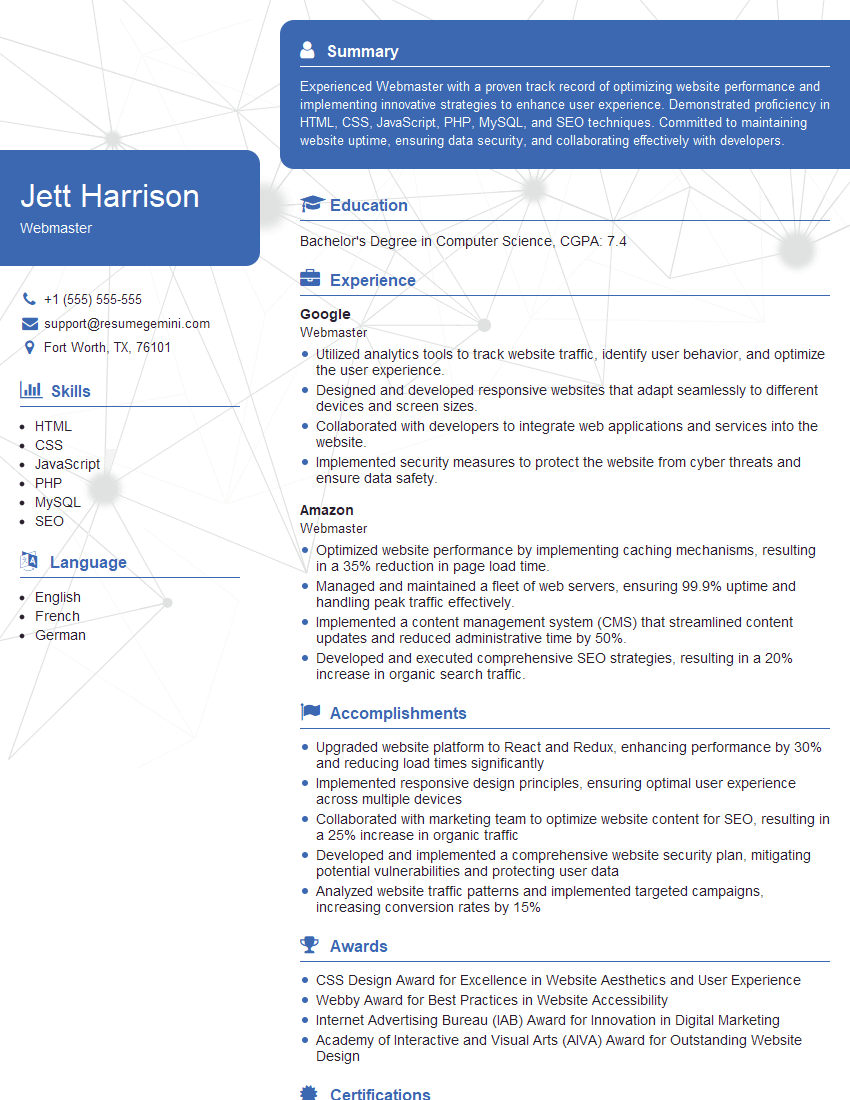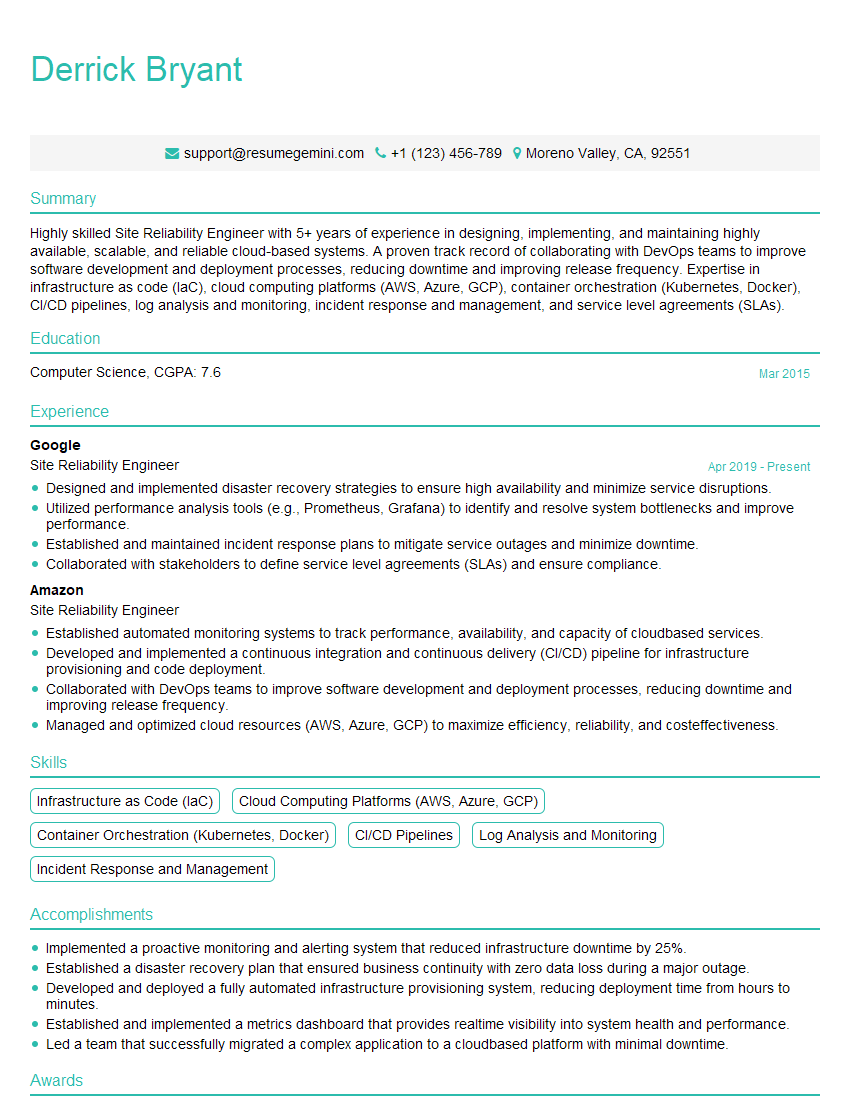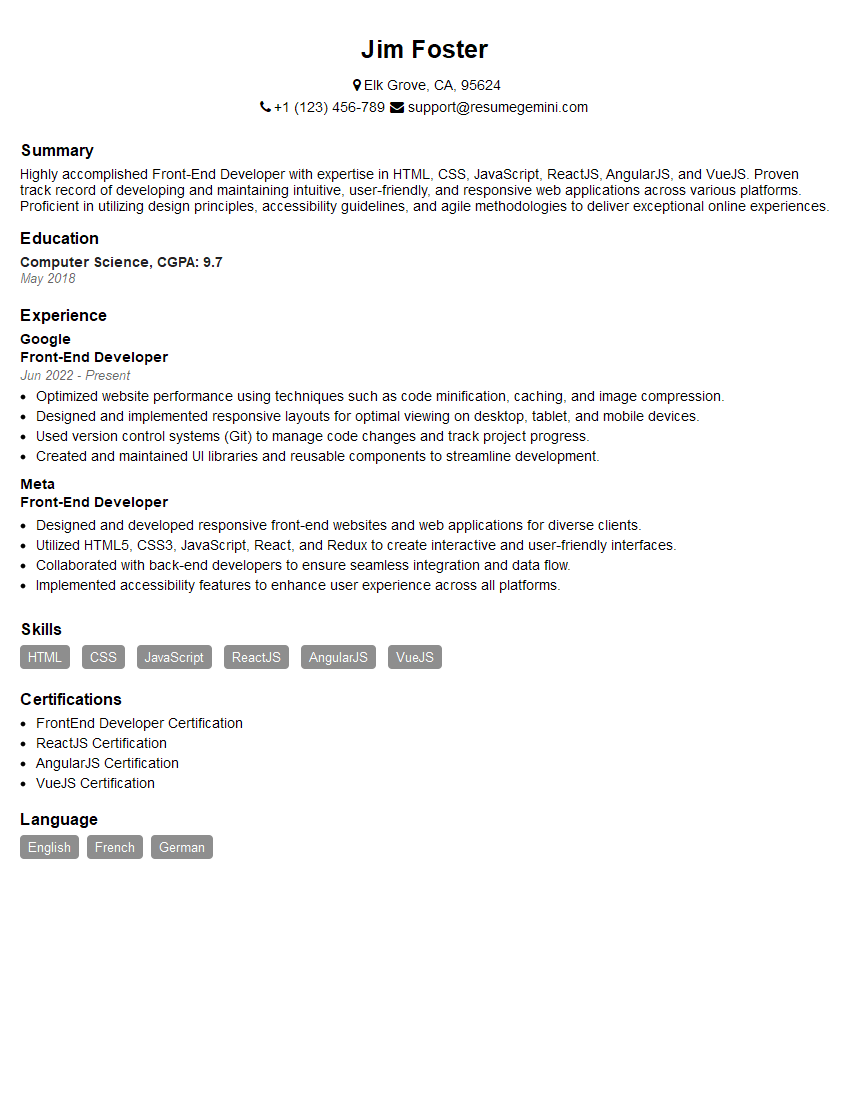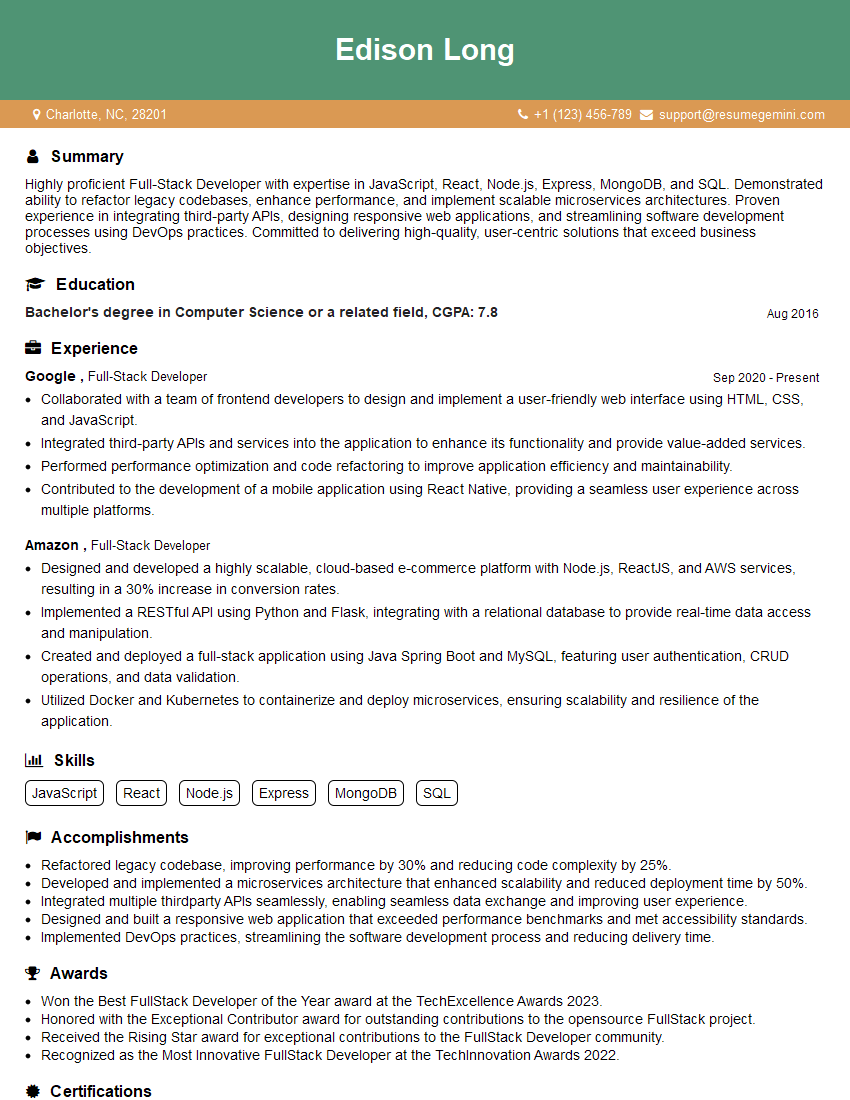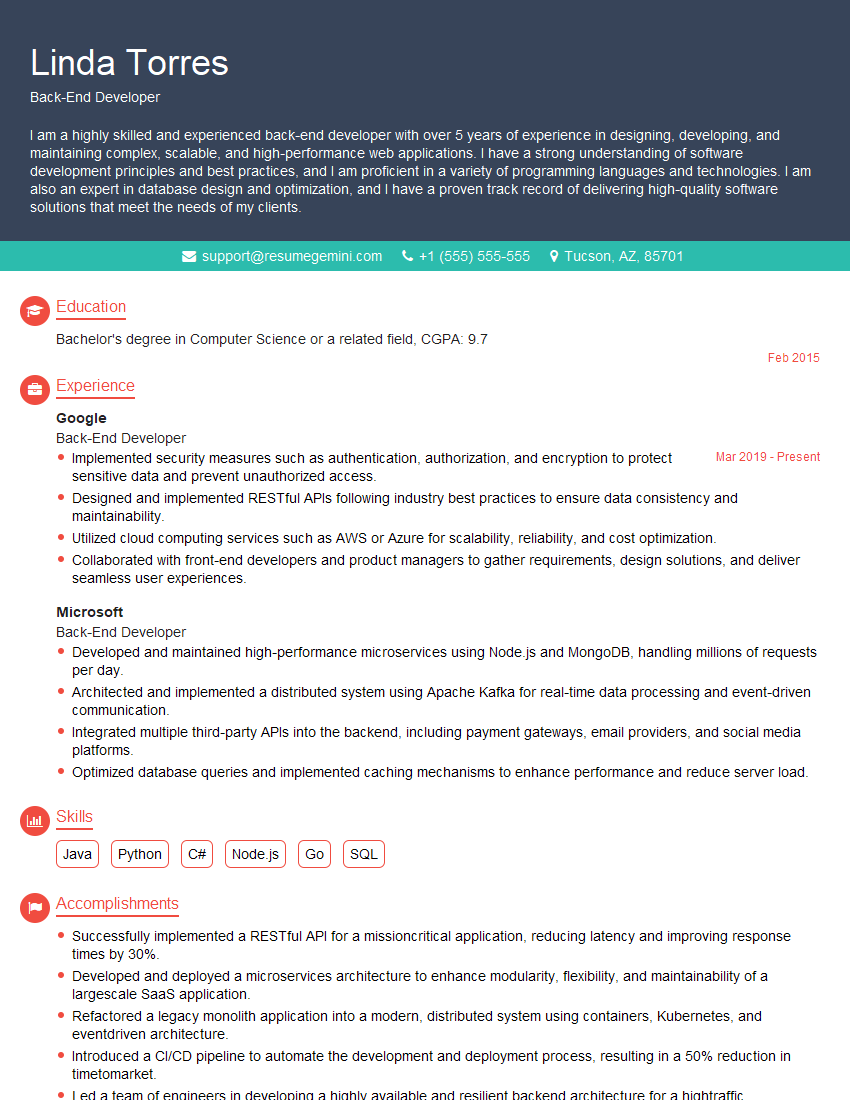The thought of an interview can be nerve-wracking, but the right preparation can make all the difference. Explore this comprehensive guide to Schema.org interview questions and gain the confidence you need to showcase your abilities and secure the role.
Questions Asked in Schema.org Interview
Q 1. Explain the purpose and benefits of using Schema.org vocabulary.
Schema.org is a collaborative, community-driven project that provides a shared vocabulary of terms and their definitions, expressed in a structured format, for marking up web pages. Think of it as a common language that websites and search engines can both understand. Its purpose is to improve how search engines and other applications understand the content on a webpage, leading to more relevant search results and richer user experiences.
The benefits are numerous. By using Schema.org vocabulary, you provide clear, unambiguous instructions to search engines about the content on your pages. This can lead to:
- Improved Search Engine Rankings: Search engines understand the context of your content better, which can significantly impact your search engine visibility.
- Rich Snippets in Search Results: Schema markup can enhance your search results with additional information like star ratings, prices, or images, making your listing stand out from the competition and increasing click-through rates.
- Enhanced User Experience: Schema helps search engines display more relevant and useful information directly in search results, creating a better user experience.
- Data Integration and Interoperability: Schema.org facilitates easier data sharing and integration between different applications and systems.
Q 2. Describe the different types of Schema.org markup.
Schema.org markup primarily uses two formats:
- JSON-LD (JavaScript Object Notation for Linking Data): This is the recommended format by Google and many other search engines. It’s embedded directly within the HTML of a webpage using a
<script>tag. It’s lightweight, easy to implement, and generally preferred for its clean separation of data and presentation. - RDFa (Resource Description Framework in Attributes): This method uses HTML attributes to embed structured data directly into existing HTML elements. It’s less common than JSON-LD, but it can be beneficial when you need to incorporate schema markup into your existing HTML structure without adding separate script tags.
- Microdata: While still supported, microdata is generally less preferred than JSON-LD because it mixes structured data with the HTML markup, which can be more difficult to maintain and update.
The choice between these formats depends on your technical skills, website architecture, and personal preference. JSON-LD is generally recommended for its simplicity and ease of use.
Q 3. How do you implement Schema.org markup on a website?
Implementing Schema.org markup involves adding structured data to your website’s HTML. The most common approach is using JSON-LD. Here’s a simplified example for a product page:
<script type="application/ld+json">{"@context":"https://schema.org","@type":"Product","name":"Example Product","description":"This is a great product.","image":"product-image.jpg","price":"29.99","sku":"ABC12345" }</script>This snippet adds structured data about a product to your page. You’ll need to replace placeholder values like "Example Product" and "product-image.jpg" with actual product details. Ideally, you would integrate this markup dynamically, pulling data from your database, to ensure accurate and consistent information across all product pages.
For other types of content (like articles, reviews, local businesses), you will use different Schema.org types and properties. Properly structured data ensures that search engines can correctly interpret the meaning of your content. For larger sites, using a schema markup generator or plugin can streamline the implementation process.
Q 4. What are the common Schema.org vocabularies used for e-commerce websites?
E-commerce websites frequently use several Schema.org vocabularies to enrich their search engine listings and enhance the user experience. Some of the most common include:
Product: Describes individual products with properties like name, description, price, image, and reviews.Offer: Specifies details about a product offer, including pricing, availability, and shipping options.AggregateRating: Displays average customer ratings and the number of reviews for a product.Review: Allows you to include individual customer reviews with details such as rating, text, and author information.BreadcrumbList: Creates a breadcrumb trail on a product page, showing the user’s navigation path.Organization: Provides details about your business, such as name, address, contact information, and logo.
Using these vocabularies together creates a rich and comprehensive representation of your products and services for search engines, leading to improved visibility and engagement.
Q 5. How does Schema.org improve SEO?
Schema.org significantly improves SEO by making your website’s content more understandable to search engines. This leads to several SEO benefits:
- Improved Ranking: Search engines can better understand the context and relevance of your pages, leading to higher rankings in search results.
- Rich Snippets: Schema markup enables rich snippets in search results, including star ratings, prices, and other visual elements, increasing click-through rates.
- Increased Click-Through Rate (CTR): Rich snippets make your listings more attractive and informative, leading to more clicks from search results.
- Better Understanding of Content: Search engines can correctly categorize your website and content, improving your visibility for relevant search queries.
- Targeted Traffic: By providing clear signals to search engines, you attract more qualified traffic that is truly interested in what you offer.
While Schema.org alone doesn’t guarantee top rankings, it’s a crucial component of a comprehensive SEO strategy.
Q 6. Explain the relationship between Schema.org and structured data.
Schema.org is the most widely used vocabulary for structured data on the web. Structured data is simply data formatted in a way that’s easily understood by both computers and humans. Think of it like a well-organized spreadsheet versus a messy pile of notes. Schema.org provides the standardized terms and relationships (the “schema”) to organize this data. It defines the properties and types of data, like ‘Product’, ‘Review’, ‘Article’, and their associated attributes (name, price, author, etc.).
In essence, Schema.org is a crucial component of structured data on the web; it’s the agreed-upon language that enables consistent and understandable data representation across different websites and applications.
Q 7. What tools can you use to validate Schema.org markup?
Several tools can validate your Schema.org markup to ensure accuracy and identify potential errors. These tools help you verify that your markup is correctly structured and understood by search engines. Some popular options include:
- Google’s Rich Results Test: A free tool that allows you to paste your HTML code or URL to check the structured data implementation.
- Schema.org’s official validator: (While not a tool in the typical sense), referencing Schema.org’s documentation is essential to ensure you’re using the vocabulary correctly and choosing the appropriate properties.
- Third-party schema validators: Various other tools from both commercial and open-source developers are available online, offering alternative ways to test your implementation.
Using these validation tools as part of your development workflow is vital to ensure that your Schema.org markup is implemented correctly and provides the intended benefits.
Q 8. How do you troubleshoot Schema.org implementation errors?
Troubleshooting Schema.org implementation errors involves a systematic approach. First, you need to validate your schema markup using tools like Google’s Rich Results Test. This tool will highlight any errors, warnings, or missing properties. Think of it as a spell-checker for your structured data. Common errors include incorrect property usage, missing required properties, or nesting issues.
Once errors are identified, meticulously review your code, comparing it to the official Schema.org documentation. Pay close attention to data types; a simple mismatch (like using a string where a number is expected) can lead to problems. If you’re using JSON-LD, ensure your JSON is properly formatted and syntactically correct.
Debugging can also involve using your browser’s developer tools to inspect the HTML and confirm that your schema markup is correctly embedded within the page’s <head> or <body> section, depending on your chosen format (JSON-LD often goes in the <head>). Finally, after making corrections, re-test using the Rich Results Test to ensure the problems have been resolved.
Q 9. What are the best practices for using Schema.org?
Best practices for using Schema.org center around accuracy, completeness, and consistency. Begin by selecting the most appropriate schema types for your content. Don’t over- or under-use schema; use only the properties that are relevant and accurate to the content on the page.
- Accuracy: Ensure all properties accurately reflect your content. Inaccurate data will hurt your search engine rankings, not help them.
- Completeness: Use all relevant properties for a given type. For example, a
Productschema should ideally includename,description,price,image, and other pertinent details. - Consistency: Maintain consistency across your entire website. Don’t use different schemas for similar content unless there’s a genuine reason. Using inconsistent schemas confuses search engines and can negate the benefits of structured data.
- Contextual Relevance: The schema must be relevant to the page’s overall content. Don’t embed schema that is unrelated to the page’s main topic.
- Regular Testing: Regularly test your schema markup with tools like the Rich Results Test to catch errors early.
Q 10. Explain the difference between JSON-LD, RDFa, and microdata.
JSON-LD, RDFa, and Microdata are all ways to embed Schema.org vocabulary into your website, but they differ in their implementation. Think of them as different languages that all convey the same information about your content.
- JSON-LD (JavaScript Object Notation for Linked Data): This is generally considered the easiest to implement and is a popular choice. It uses a separate JSON object to embed the schema data, typically within the
<head>of your HTML document. Here’s an example:
- RDFa (Resource Description Framework in attributes): This method embeds the schema data as attributes within the existing HTML elements. It’s more complex to implement than JSON-LD, but it keeps the schema data directly within the HTML.
- Microdata: Similar to RDFa, Microdata uses attributes to embed schema data, but it uses different attribute names. It’s considered less flexible and more difficult to maintain than JSON-LD.
Choosing the best format often depends on developer preference and existing website architecture. JSON-LD is often preferred for its simplicity and ease of integration.
Q 11. How do you choose the appropriate Schema.org vocabulary for a given piece of content?
Selecting the appropriate Schema.org vocabulary requires careful consideration of the content’s nature and purpose. Begin by thoroughly analyzing your content to determine its core type. Is it a product, an article, a local business, an event, etc.? Once you’ve identified the primary type, look for the corresponding Schema.org class. For example, a product page would use the Product type, a blog post would use BlogPosting, and a local business would use LocalBusiness.
After choosing the main type, explore the properties available for that type. Only include properties that are relevant and accurate to your content. Avoid including unnecessary or irrelevant properties. Think of it as describing your content in the most concise and accurate way possible. Use the Schema.org documentation extensively during this process.
If your content is complex and doesn’t neatly fit into a single type, you might need to use nested schemas or multiple types. However, ensure this is done correctly and avoid creating overly complex structures.
Q 12. Describe a situation where using Schema.org improved website performance.
I worked with a client who owned an e-commerce website selling handcrafted jewelry. Their organic search traffic was low, and conversions were even lower. After implementing Schema.org markup (specifically, using Product, Offer, and AggregateRating schemas), we saw a significant improvement in their search engine rankings.
The rich snippets that appeared in search results, showcasing product names, prices, images, and customer reviews (thanks to AggregateRating), significantly increased the click-through rate. This, in turn, resulted in a substantial increase in website traffic and sales. The clear and concise information provided by the rich snippets made their products more attractive to potential customers, boosting their conversion rates. It was a clear demonstration of how structured data can improve website visibility and drive business results.
Q 13. How do you handle schema conflicts?
Schema conflicts arise when you have conflicting or contradictory information within your schema markup or between different schemas on the same page. This can confuse search engines, leading to poor indexing or no rich results at all. The key is to identify the conflict and resolve it by prioritizing the most accurate and relevant data.
For example, if you have two Organization schemas on a page describing different aspects of the business, that may cause issues. A conflict could also exist between the declared type and the properties used. If you have a `Product` with a `dateCreated` property, for instance, that might be viewed as incongruent.
To resolve conflicts, carefully review your schema markup. Identify any conflicting information and prioritize the most accurate and consistent data. Remove redundant or contradictory schemas, and ensure that your schemas are logically structured and consistent with your page content. Use the Rich Results Test to check for errors, and remember that less is more. Overly complex schemas can be as problematic as contradictory ones.
Q 14. What are the potential drawbacks of using Schema.org?
While Schema.org offers numerous benefits, there are potential drawbacks to consider.
- Maintenance Overhead: Implementing and maintaining schema markup requires ongoing effort. Changes to your website structure or content may necessitate updates to your schema, requiring testing and validation.
- Complexity: Schema.org can be complex, especially for those unfamiliar with structured data. Understanding the different schema types and their properties requires time and effort.
- No Guarantee of Rich Results: Even with correctly implemented schema markup, there’s no guarantee that search engines will display rich snippets. Search engines use many factors to determine which results to enhance.
- Potential for Misinformation: Inaccurate or misleading schema markup can negatively impact your website’s performance and credibility.
Despite these drawbacks, the benefits of using Schema.org often outweigh the potential downsides, particularly for e-commerce sites, local businesses, and content-rich websites.
Q 15. How does Schema.org impact search engine rankings?
Schema.org doesn’t directly influence search engine rankings in a way that guarantees higher placement. Instead, it acts as a powerful signal, enhancing how search engines understand your website’s content. Think of it as providing a detailed instruction manual to search engines. By using Schema.org vocabulary, you explicitly tell Google, Bing, and others what your content is about. This clear communication allows search engines to more accurately index and display your content in search results, leading to increased visibility and potentially higher click-through rates (CTR). A well-structured page with rich snippets, enabled by accurate Schema markup, is simply more attractive and informative to users scanning SERPs (Search Engine Results Pages).
For example, if you’re selling books, implementing the Book schema type allows you to display the book’s title, author, price, and reviews directly in the search results, boosting the attractiveness and click potential of your listing.
Career Expert Tips:
- Ace those interviews! Prepare effectively by reviewing the Top 50 Most Common Interview Questions on ResumeGemini.
- Navigate your job search with confidence! Explore a wide range of Career Tips on ResumeGemini. Learn about common challenges and recommendations to overcome them.
- Craft the perfect resume! Master the Art of Resume Writing with ResumeGemini’s guide. Showcase your unique qualifications and achievements effectively.
- Don’t miss out on holiday savings! Build your dream resume with ResumeGemini’s ATS optimized templates.
Q 16. Explain how Schema.org can enhance user experience.
Schema.org improves user experience by making information more accessible and understandable. Search engines use Schema.org data to generate rich snippets – those enhanced search results that include things like star ratings, prices, or event dates. This enriched information allows users to quickly grasp the essence of your content without even clicking through. Richer results mean users find the information they need faster and more efficiently, leading to greater satisfaction.
Imagine searching for a recipe; a rich snippet displaying the cooking time, ingredients, and a star rating directly in the search results would be much more helpful than just a plain text link. Schema.org makes this enriched experience possible.
Furthermore, Schema.org can support structured data markup for navigation, improving website usability and accessibility. Clear, well-organized content benefits all users, especially those with disabilities.
Q 17. Describe how you would audit a website’s existing Schema.org implementation.
Auditing a website’s Schema.org implementation is a multi-step process. I’d start by using a Schema validator tool (there are many free and paid options available) to scan the website’s HTML for Schema markup and check for errors. This identifies any immediate issues like syntax problems or missing properties. Next, I would manually review a sample of pages, checking the accuracy and relevance of the applied Schema. Does the markup accurately reflect the page’s content? Are the properties used appropriate for the page type?
Beyond validation, I’d analyze the search results to see if the rich snippets are appearing as expected. If not, this indicates a problem with either the markup itself or its implementation. I would also check for inconsistencies. Are the same Schema types used consistently across similar pages? Are there any conflicts between different Schema types on a single page? Finally, I’d look for opportunities for improvement. Are there any relevant Schema types missing that could further enhance the search engine’s understanding of the page’s content?
The entire process combines automated tools for efficient large-scale scanning and manual review for accuracy and context.
Q 18. How can you ensure that your Schema.org markup is accurate and up-to-date?
Ensuring accuracy and up-to-dateness requires a combination of diligent practices. First, always consult the official Schema.org vocabulary directly. The site is regularly updated, so reliance on outdated documentation or tutorials is a major risk. Second, use a structured approach to implementing Schema, maybe through a dedicated Schema management plugin or by developing robust templates to ensure consistency. This helps prevent errors stemming from manual changes across many pages.
Regular auditing (as described in the previous answer) is crucial. Schedule automated checks and manual reviews to catch any accidental deletions or updates that render Schema ineffective or inaccurate. Staying current with changes to Schema.org and best practices is vital, which often means following industry blogs, participating in online communities, and attending relevant workshops or conferences.
Q 19. What are some common Schema.org errors and how do you fix them?
Common Schema.org errors include:
- Syntax errors: Missing brackets, incorrect property names, or typos in JSON-LD code. These often lead to the entire markup being ignored.
- Incorrect property usage: Using properties that are not relevant to the page’s content or using them in the wrong context. For instance, using
priceCurrencyfor a free product. - Missing required properties: Omitting critical pieces of information, such as the
nameproperty for many Schema types. - Conflicts between Schema types: Applying multiple, contradictory schema types to the same page which causes confusion for search engines.
- Incorrect nesting of Schema: Improperly structuring nested Schema, making it difficult for search engines to parse.
Fixing these errors involves using a Schema validator to pinpoint the issue, checking the official Schema.org documentation to ensure correct property usage, and carefully reviewing and correcting the code based on the identified errors.
Q 20. How does Schema.org work with other SEO techniques?
Schema.org works synergistically with other SEO techniques. It’s not a standalone solution but a powerful complement to other strategies. For instance, high-quality content is still paramount; Schema helps search engines better understand that content. Keyword optimization remains vital; Schema helps to contextualize those keywords. A strong link-building strategy remains important; Schema provides additional signals to enhance the overall authority of the site.
Think of Schema as providing another layer of information to the foundation of solid SEO practices. It’s about comprehensively communicating the value of your website and its content to search engines.
Q 21. Explain the concept of schema nesting.
Schema nesting refers to embedding one Schema type within another. This allows for more detailed and nuanced representation of complex data. For instance, a Product schema might contain a nested Offer schema to describe the price and availability. Similarly, an Article schema could contain a nested Person schema for the author.
{
"@context": "https://schema.org/",
"@type": "Product",
"name": "Example Product",
"offers": {
"@type": "Offer",
"price": "29.99",
"priceCurrency": "USD"
}
}
Proper nesting significantly improves the richness and accuracy of the data provided to search engines, leading to more detailed and informative rich snippets. However, it’s crucial to ensure the nesting is semantically correct and follows Schema.org guidelines to avoid errors.
Q 22. How do you measure the effectiveness of your Schema.org implementation?
Measuring the effectiveness of your Schema.org implementation involves a multi-faceted approach. It’s not just about adding the code; it’s about seeing tangible improvements. We need to track how Schema.org impacts key performance indicators (KPIs).
Increased Rich Snippets in Search Results: The most direct measure is observing the appearance of rich snippets – those enhanced search results with extra information like star ratings, prices, or author photos. Regularly check your website’s appearance in search results for relevant keywords.
Improved Click-Through Rate (CTR): Rich snippets are visually appealing and often lead to higher CTR. Track your CTR from search engines to determine if Schema.org is driving more traffic.
Enhanced Position in Search Results (SERP): While not guaranteed, Schema.org can indirectly boost your ranking. Monitor your search engine rankings to see if there’s a correlation with your implementation.
Google Search Console Data: Google Search Console provides detailed reports on structured data, highlighting errors and successes. This is an invaluable tool for identifying and resolving issues.
Conversion Rate Optimization (CRO): If your goal is e-commerce, track your conversion rate (sales, sign-ups, etc.). Schema.org can subtly influence user behavior, so monitor this KPI for positive changes.
Think of it like this: you wouldn’t launch a marketing campaign without tracking its ROI. Similarly, you need to track how Schema.org contributes to your overall online success.
Q 23. What are the latest updates and changes in Schema.org?
Schema.org is constantly evolving. Keeping up-to-date is crucial. Recent updates often focus on refining existing vocabularies and adding new ones to address emerging trends and technologies. For example, there have been significant updates related to:
Improved support for specific industries: More nuanced schemas are being developed for sectors like healthcare, finance, and education, allowing for more precise data representation.
Enhanced event representation: Schema.org has expanded its vocabulary to better represent virtual and hybrid events, along with the details of various event aspects, including ticketing and accessibility.
Better handling of creative works: More attributes have been added to better represent different types of creative works, allowing richer descriptions.
Focus on accessibility: Updates emphasize making structured data more accessible and inclusive for users with disabilities.
Staying current involves regularly checking the official Schema.org website, subscribing to their announcements, and using tools that monitor Schema.org changes. Ignoring updates can lead to inaccuracies and missed opportunities.
Q 24. Explain the importance of context when using Schema.org.
Context is paramount in Schema.org. It dictates how search engines and other applications interpret your structured data. Without proper context, your meticulously crafted Schema.org markup can be misinterpreted or ignored.
Consider this analogy: saying “The bank is closed” is ambiguous. It could refer to a river bank or a financial institution. Similarly, without proper context, Acme Corp could be a company, a product name, or something else.
Establishing context involves:
Using appropriate schema types: Choosing the correct schema type (e.g.,
Product,Article,LocalBusiness) sets the stage for accurate interpretation.Proper nesting and relationships: Ensure that nested items are appropriately linked and related to the parent item to show their context. For example, a product review nested within the product schema.
Clear property values: Using precise and unambiguous values for your properties avoids misinterpretations.
Consistent and accurate data: Maintain consistency across your structured data and make sure it accurately reflects your content.
Failure to establish proper context can lead to poor search engine understanding and render your Schema.org implementation ineffective.
Q 25. How would you handle a situation where a Schema.org property doesn’t accurately reflect your content?
If a Schema.org property doesn’t accurately reflect your content, you have several options, none of which involve using inaccurate information:
Use a more appropriate property: Schema.org provides a rich vocabulary. If the existing property doesn’t fit, explore alternatives. The official documentation is your best resource.
Refine your content: The problem may lie in your content, not the schema. Make sure your content aligns with the schema you’re using.
Use additional properties: Sometimes, you may need to use multiple properties to fully describe your content.
Avoid the property entirely: If no suitable property exists, omitting it is preferable to using an inaccurate one.
Consider custom vocabularies (with caution): As a last resort, and only if absolutely necessary, explore creating custom vocabulary extensions but ensure alignment with best practices.
Always prioritize accuracy. Inaccurate Schema.org data can hurt your reputation and rankings. It’s better to omit information than provide misleading data.
Q 26. What are some alternative methods to structured data besides Schema.org?
While Schema.org is the most widely adopted standard for structured data, alternatives exist, though they often lack the breadth and community support of Schema.org.
Microdata (deprecated): This was an early method of adding structured data to websites, but it’s now considered outdated in favor of RDFa or JSON-LD.
RDFa (Resource Description Framework in Attributes): RDFa uses attributes within HTML to embed structured data. It is more complex than JSON-LD but can be quite powerful.
JSON-LD (JavaScript Object Notation for Linked Data): This is the recommended format by Google and many others. It uses a separate JSON object to represent the structured data. This is generally preferred for its simplicity and ease of implementation.
Proprietary Schemas (Industry-Specific): Certain industries might use their own proprietary schemas, though this usually involves integrating with specific platforms or services.
The choice often depends on the complexity of the data and the platform’s requirements. However, Schema.org remains the most versatile and widely supported choice for broad web accessibility.
Q 27. Compare and contrast different Schema.org types for representing products and services.
Schema.org offers various types for representing products and services, each with nuances:
Product: This is the general type for physical goods. It includes properties likename,description,price,image,brand,sku, and more. Think of a shirt, a book, or a smartphone.Service: This represents intangible services. Think of a haircut, car repair, or consulting services. Key properties often includename,description,areaServed,priceRange, andprovider.Offer: Represents a specific offer for a product or service. It’s often used in conjunction withProductorServiceto specify pricing, availability, and other terms.AggregateOffer: Useful for showcasing multiple offers, like when you have different variations of a product or service (e.g., different colors or sizes).
The key difference lies in the tangibility of the offering. Product is for physical goods, while Service is for intangible services. Offer and AggregateOffer provide details about the pricing and availability of these offerings.
For example, a website selling handmade sweaters might use Product to describe individual sweaters and AggregateOffer to show various sizes and colors available. A website offering online tutoring would use Service and potentially Offer to list prices for different tutoring packages.
Q 28. How can you use Schema.org to improve the click-through rate of your search results?
Schema.org can significantly improve your search result click-through rate (CTR) by making your listings more attractive and informative.
Rich Snippets: Schema.org enables rich snippets, making your search result stand out with visually appealing elements like star ratings, prices, images, or even reviews. This attracts more clicks.
Clearer Information: By providing structured data, you ensure that search engines understand your content precisely, leading to more relevant search result listings. When the description accurately reflects the content, people are more inclined to click.
Increased Trust and Credibility: Things like review stars, ratings, and verified seals of approval, when structured properly with Schema.org, improve user trust, thereby leading to more clicks.
Improved Mobile Experience: Schema.org’s structured data contributes to a better mobile search experience, improving user engagement and encouraging clicks from mobile users.
Think of it as dressing up your shop window. A well-decorated window with clear signs and attractive visuals draws more customers. Similarly, well-structured data, made visible through rich snippets, draws more clicks from users.
Key Topics to Learn for Schema.org Interview
- Core Vocabulary: Understand the fundamental schema types and properties. Grasp the relationships between different schema types and how they interrelate to create rich, descriptive data.
- Practical Application: SEO & Rich Snippets: Learn how to implement Schema.org markup to enhance your website’s search engine visibility. Explore how structured data improves click-through rates and organic search rankings.
- Schema.org for Different Content Types: Understand how Schema.org is applied to various content formats, including articles, products, events, recipes, and local businesses. Practice identifying the appropriate schema for different scenarios.
- JSON-LD Implementation: Master the practical implementation of Schema.org using JSON-LD. Understand how to correctly embed structured data within your website’s HTML code.
- Schema Validation and Troubleshooting: Learn how to validate your Schema markup using tools like Google’s Rich Results Test. Develop the ability to identify and resolve common Schema implementation errors.
- Advanced Schema Concepts: Explore more complex schema types and properties relevant to your specific area of expertise. This could include nested schemas, custom vocabularies, or advanced features like schema aggregation.
- Problem-Solving with Schema: Practice diagnosing issues related to incorrect schema implementation, including identifying errors and proposing effective solutions. Develop your troubleshooting skills.
Next Steps
Mastering Schema.org is crucial for career advancement in web development, SEO, and data management. A strong understanding of structured data significantly improves your value to employers. To further boost your job prospects, create an ATS-friendly resume that highlights your Schema.org expertise. ResumeGemini is a trusted resource to help you build a professional and effective resume that showcases your skills. Examples of resumes tailored to Schema.org expertise are available, providing you with a strong foundation for your job search.
Explore more articles
Users Rating of Our Blogs
Share Your Experience
We value your feedback! Please rate our content and share your thoughts (optional).
What Readers Say About Our Blog
Hi, I’m Jay, we have a few potential clients that are interested in your services, thought you might be a good fit. I’d love to talk about the details, when do you have time to talk?
Best,
Jay
Founder | CEO





